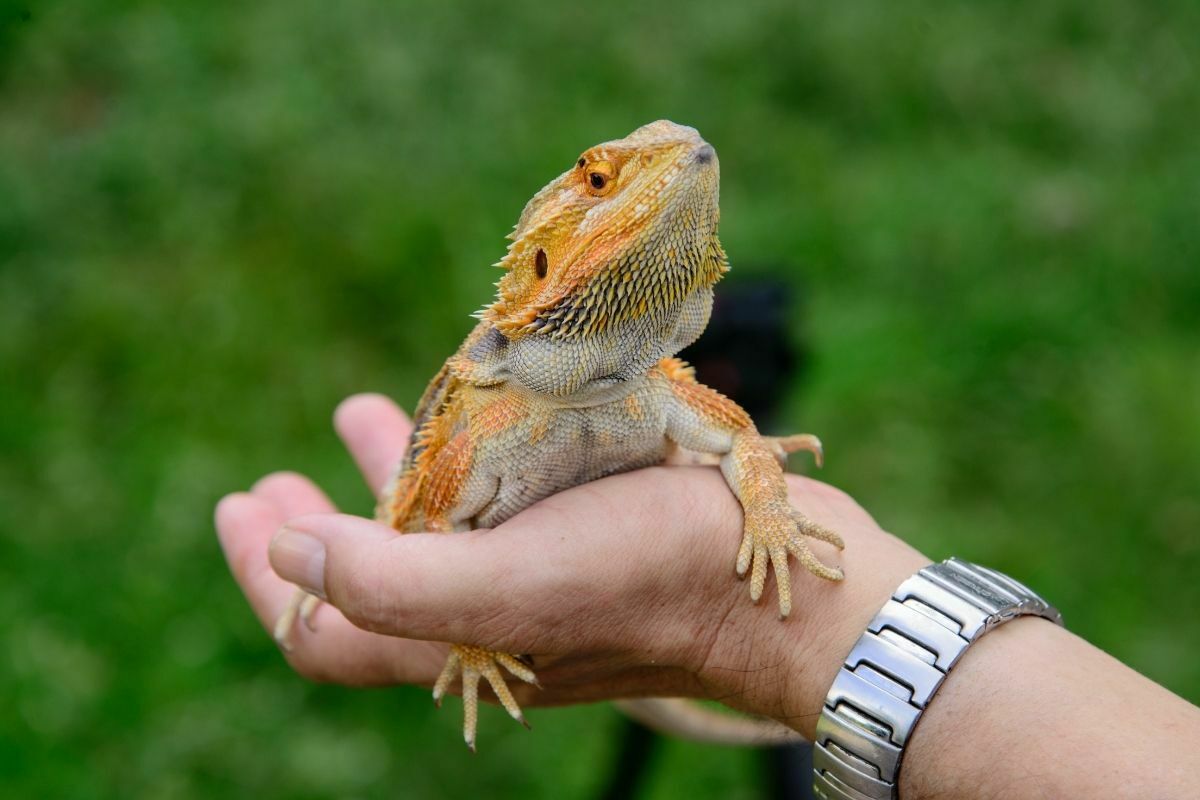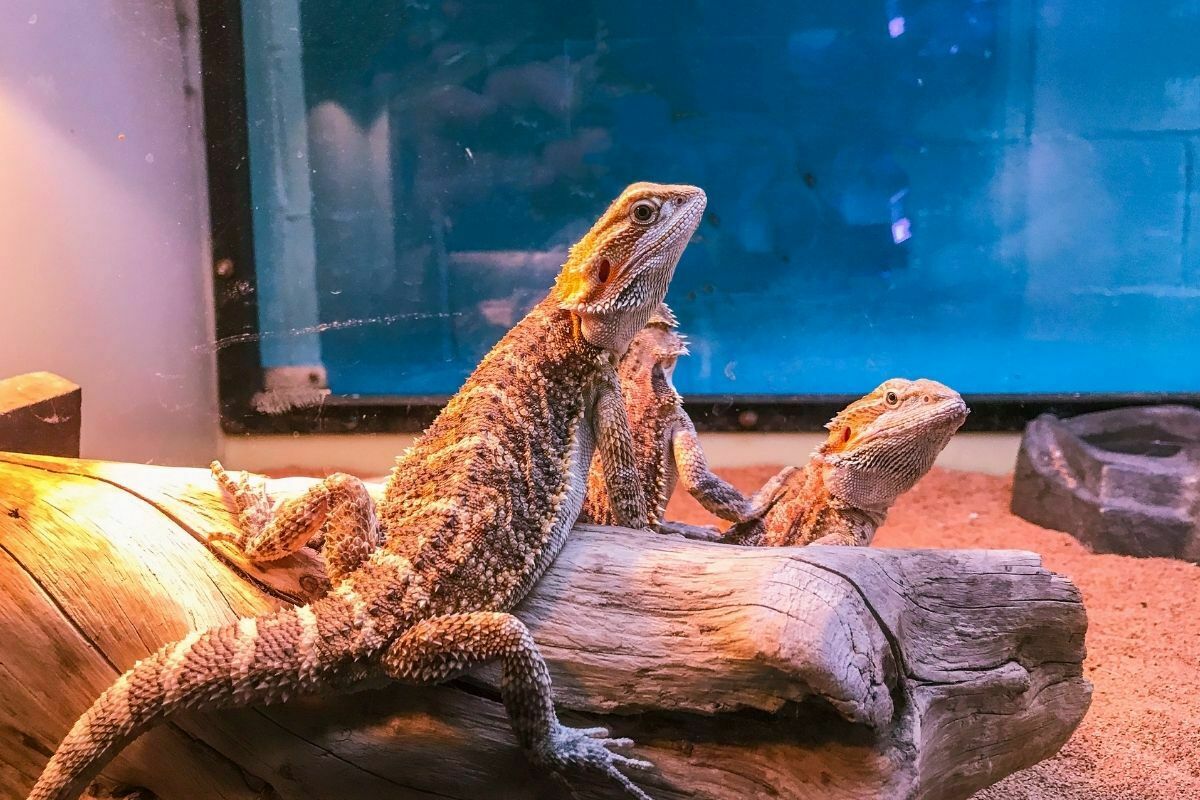Consider yourself on vacation; you’re lounging on the beach, soaking up the sun, and everything is lovely. What happens once a certain period of time has passed?

If you are not capable of tanning continuously for 12 hours, you will need to depart and cool off. Perhaps you’re submerged in water, or perhaps you’re just looking for shade.
This is the typical life of bearded dragons. They sleep in the sun and enjoy the heat for hours; they control their body temperature by opening their lips, and if they get too hot, they shift to a cooler spot.
This article will teach you how to determine the temperature requirements of your bearded dragon, which temperatures are critical for your bearded dragon tank, and how to reach those temperatures.
What Temperature Is Right For Bearded Dragons?
The majority of inexperienced bearded dragon owners have no idea how hot the bearded dragon hotspot must be. The heated zone should be between 95 and 105 degrees Fahrenheit in temperature.
We suggest aiming towards the center and using a temperature of 100 degrees Fahrenheit.
We recommend that you build a heated zone with varying degrees of intensity for your dragon. In this manner, your bearded dragon may choose between slightly increased heat and none at all. We suggest obtaining some Mopani wood to do this.
Place it in front of the basking light to give your bearded dragon a choice of resting positions.
One should be near the basking bulb, while the other should be further away. Maintain a temperature of 95 to 100 degrees Fahrenheit in such regions once more.
How Can You Reach Necessary Temperatures For Bearded Dragons?
You’re probably wondering what kind of heater and fixture to use. You have a variety of alternatives available to you here. You might also get a reptile basking light.
Essentially, you’ll need a warm-to-the-touch 100W bulb. If your 100W bulb does not achieve the appropriate temperature, you may either reduce the distance between the light and the basking position or switch to a higher-wattage bulb (150W).
What Ambient Temperature Is Right For Bearded Dragons?

The ambient temperature setting relates to the overall temperature of your beardie tank. Between 78 and 88 degrees Fahrenheit is an ideal temperature range. It will probably be warmer near the basking area and somewhat cooler on the side of your tank without a basking spot.
That is just what you want as long as the temperature does not exceed 78 degrees Fahrenheit.
Allow your bearded dragon to cool down. You may also help your bearded dragon cool off by putting a hide on the cool side of your terrarium and mixing it with a burrowing substrate.
If you’re worried about the effects on your bearded dragon, we recommend using the substrate advised in this thread.
If you are unable to achieve this ambient temperature, you should increase the temperature in your tank with a comparable heat lamp. If the temperature becomes too high, use a bulb with a lower wattage.
What Night Time Temperature Is Right For Bearded Dragons?
Numerous people struggle to maintain an appropriate overnight temperature of roughly 70 degrees Fahrenheit. This temperature is readily obtained if you do not keep your dragon tank in a basement.
If the tank’s temperature drops below 70 °F at night, we recommend installing a ceramic heater.
Keep in mind that a lower nighttime temperature will keep your bearded dragon from baking.
Frequently Asked Questions
Are Bearded Dragons Good Pets?
Due to their normally tranquil and amiable demeanor, bearded dragons make wonderful pets. They are often submissive, and their behavior improves with age.
Bearded dragons are excellent pets for youngsters. They are generally peaceful and gentle creatures. Children will eventually learn how to cope with them and develop a strong relationship with them.
It’s easy to care for them, but they need constant feeding, attention, and maintenance. In a low-risk setting, a bearded dragon may teach youngsters how to care for a pet and instill a sense of responsibility.
Additionally, bearded dragons thrive on consistency, which implies that caring for one may help youngsters acquire time management skills. Your bearded dragon’s cage should be cleaned and fed on a consistent schedule.
Additionally, owing to their relatively long lifespan, bearded dragons make wonderful pets. You should be able to maintain these little animals for a lengthy amount of time with adequate care.
Indeed, they may live between the ages of 8 and 15! This means you’ll have more time to interact, play, and just enjoy your time together.
Are Bearded Dragons Easy To Look After?
Bearded dragons are low-maintenance pets that are perfect for busy youngsters and adults.
After you’ve built the right environment for your bearded dragon, complete with the correct temperature and lighting settings (including a wonderful UVB lamp), caring for them is a straightforward and low-maintenance endeavor.
A 55-75 gallon tank with a robust screen top is ideal for an adult bearded dragon. While bearded dragons may be kept in smaller aquariums as juveniles, they quickly outgrow them.
Provide your beardie with a balanced diet and plenty of clean water. These lizards consume a diverse array of insects, fruits, and vegetables, ensuring that they are never hungry. Furthermore, the bulk of the things they recommend is rather reasonable!
Keeping your bearded dragon in a clean environment is easy. It just takes a few minutes each day to clean up any rotten food, provide clean water for your lizard, and remove its droppings.
Once a week, thoroughly clean your reptile’s tank to keep it healthy and happy. In comparison to other readily accessible pets, this is a low-maintenance choice.
Are Bearded Dragons Expensive?
In comparison to other pets, bearded dragons are quite affordable to keep. To begin, you’ll want to invest in an enclosure that is suitable for your lizard.
Because you’ll want to invest in a high-quality terrarium, thermometer, and light source, the expense of setting up an environment for your bearded dragon is likely to be between $200 and $600.
Once a terrarium has been constructed for your bearded dragon, they are a rather low-maintenance pet. Numerous products that these reptiles make use of are affordable. Additionally, you will need substrate for its terrarium, although this may be relatively economical at times (or even free).
Like other pets, such as cats and dogs, bearded dragons need regular veterinarian examinations.
While you may need to see a veterinarian specializing in reptiles, your veterinary expenditures will probably be less than those of cat or dog owners (we also recommend getting pet insurance to cover you if any surprises occur).
Final Thoughts
Bearded dragons are cold-blooded, meaning they must self-regulate their body temperature.
They need a morning sunbath to acclimate their bodies; otherwise, they would be unable to seek food or defend their area throughout the day against other bearded dragons.
It is critical to have enough illumination while breeding bearded dragons. As a consequence, you should constantly ensure that your lighting is of the best quality and that your thermostat is appropriately calibrated.
The majority of bearded dragon owners choose the inexpensive two-in-one thermometers that retail for under $5. Bearded dragons are an investment, but proper temperature regulation is critical.
Simply mounting a low-cost temperature sensor on the back of your tank is inadequate.
Inappropriate temperatures may lead your bearded dragon to grow weak, unable to hunt effectively, and finally ill. As a consequence, investing in a good thermometer.
I’d like to recommend the following thermometers to you. It is quite accurate and may be used to rapidly determine the temperature of a heated room.
